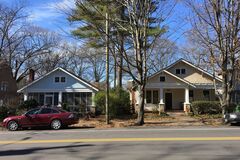CANDLER PARK HIstoric Designation resources
Summaries of the Poncey Highland HD regulations
In our research we have looked at Atlanta's most recent historic district, Poncey Highland (PHHD), as an example of "historic district light" in terms of regulations. There would be differences in the PHHD regulations include Development controls normally included in the underlying Zoning code which CP does hope to use these as a starting point for drafting our potential Candler Park HD regulations:
In our research we have looked at Atlanta's most recent historic district, Poncey Highland (PHHD), as an example of "historic district light" in terms of regulations. There would be differences in the PHHD regulations include Development controls normally included in the underlying Zoning code which CP does hope to use these as a starting point for drafting our potential Candler Park HD regulations:
- Sample Procedures (PHHD)
- Sample Historic Building Regs (PHHD)
- Sample Non-Historic Building Regs (PHHD)
- Sample New Construction Regs (PHHD)
- Sample Districtwide Regs (PHHD) - note this section includes some regulations typically covered by the underlying Zoning Regulations (ie, R-5, R-4, C-1) in this respect PHHD and a potential CPHD would likely differ.


